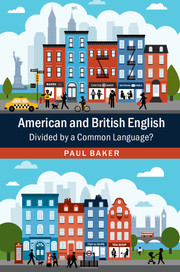Book contents
- American and British English
- American and British English
- Copyright page
- Contents
- Figures
- Tables
- Acknowledgements
- 1 Introduction
- 2 Spelling Differences
- 3 Letter Sequences and Affixation
- 4 Higher-Frequency Words
- 5 Lower-Frequency Words
- 6 Part of Speech Categories
- 7 Semantic Categories
- 8 Swearing, Identity and Discourse Markers
- 9 Conclusion
- References
- Index
- References
References
Published online by Cambridge University Press: 21 September 2017
- American and British English
- American and British English
- Copyright page
- Contents
- Figures
- Tables
- Acknowledgements
- 1 Introduction
- 2 Spelling Differences
- 3 Letter Sequences and Affixation
- 4 Higher-Frequency Words
- 5 Lower-Frequency Words
- 6 Part of Speech Categories
- 7 Semantic Categories
- 8 Swearing, Identity and Discourse Markers
- 9 Conclusion
- References
- Index
- References
- Type
- Chapter
- Information
- American and British EnglishDivided by a Common Language?, pp. 254 - 260Publisher: Cambridge University PressPrint publication year: 2017



